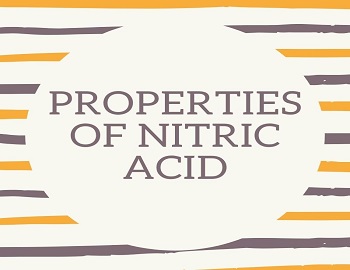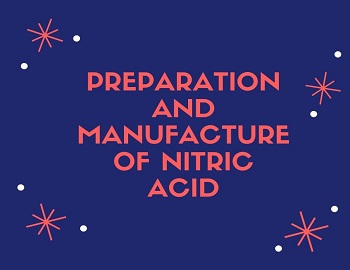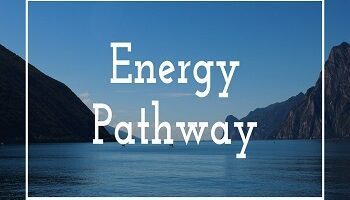Table of Contents
Properties of Nitric Acid:
Physical Properties of Nitric Acid:
- Pure nitric acid is a colourless liquid.
- It has a characteristic pungent and choking smell.
- It is soluble in water in all proportions.
- It is extremely corrosive and causes painful sores on the skin. It fumes in air.
- Its specific gravity is 1.52. Its melting point and boiling point are -42°C and 86°C, respectively.
Chemical Properties of Nitric Acid:
(1) Stability- Nitric acid undergoes decomposition on heating to give nitrogen dioxide, oxygen and water.
| 4HNO3 ———-> 4NO2 + O2 + 2H2O |
(2) Acidic Properties- It is a strong acid and ionizes in aqueous solution as under-
| HNO3 ———-> H+ + NO3– |
(a) Action of blue litmus paper- It turns blue litmus paper red.
(b) Action of alkalis- It neutralizes alkalis to give salt and water. Example-
| NaOH + HNO3 ———-> NaNO3 + H2O |
(c) Action of metallic carbonate and bicarbonate- Nitric acid decomposes metallic carbonate and bicarbonate.
| Na2CO3 + 2HNO3 ———-> 2NaNO3 + CO2 + H2O NaHCO3 + HNO3 ———-> NaNO3 + CO2 + H2O |
(d) Action of metallic oxides- It reacts with metallic oxides to give the corresponding salt and water.
| CaO + 2HNO3 ———-> Ca(NO3)2 + H2O |
(3) Oxidizing Properties- Nitric acid is a powerful oxidizing agent.
| Dilute: 2HNO3 ———-> 2NO + H2O + 3 (O) Concentrated: 2HNO3 ———-> 2NO2 + H2O + (O) |
Nitric acid oxidizes a number of substances.
(a) Oxidation of non-metals- Concentrated HNO3 oxidizes non-metals such as carbon, sulfur and phosphorous.
| C + 4HNO3 ———-> 4NO2 + 2H2O + CO2 S + 6HNO3 ———-> 6NO2 + 2H2O + H2SO4 |
(b) Oxidation of metalloids- Concentrated HNO3 oxidizes metalloids such as tin, arsenic and antimony to give their oxy-acids.
| Sn + 4HNO3 ———-> H2SnO3 (meta-stannic acid) + 4NO2 + H2O As + 5HNO3 ———-> H3AsO4 (arsenic acid) + 5NO2 + H2O |
(c) Oxidation of metals- The oxidation of metals depends upon the factors like concentration of nitric acid used, order of activity of metals and temperature of reaction. Most of the metals react with concentrated HNO3 to give NO2 and with dilute HNO3 to evolve NO. Only a few metals react with very dilute nitric acid to evolve hydrogen gas. Let us consider a few examples-
- Action of copper- With dilute HNO3, copper gives copper nitrate, water and nitric oxide. With concentrated HNO3, copper yields copper nitrate, water and nitrogen dioxide.
| Dilute: 3Cu + 8HNO3 ———–> 3Cu(NO3)2 + 2NO + 4H2O Concentrated: Cu + 4HNO3 ———–> Cu(NO3)2 + 2NO2 + 2H2O |
- Action of zinc- Nitric acid reacts with zinc as under-
| Very dilute acid: 4Zn + 10HNO3 ———–> 4Zn(NO3)2 + 3H2O + NH4NO3 Dilute acid: 3Zn + 8HNO3 ———–> 3Zn(NO3)2 + 4H2O + 2NO Concentrated acid: Zn + 4HNO3 ———–> Zn(NO3)2 + 2H2O + 2NO2 |
- Action of magnesium- Magnesium reacts with very dilute HNO3 (say 1%) to give hydrogen gas.
| Very dilute acid: Mg + 2HNO3 ———–> Mg(NO3)2 + H2 Similar is the case with manganese i.e. Mn + 2HNO3 ———–> Mn(NO3)2 + H2 |
- Oxidation of compounds- Nitric acid oxidizes a number of compounds, for instance, H2S, KI and FeSO4.
| H2S + 2HNO3 ———–> 2H2O + 2NO2 + S 6KI + 8HNO3 ———–> 6KNO3 + 2NO + 4H2O |
(4) Action of Aqua regia- A mixture of HCl and HNO3 in the ratio of 3:1 is referred to as aqua regia. This mixture is capable of dissolving noble metals like gold and platinum.
| 3HCl + HNO3 ———-> 2H2O + NOCl + 2Cl Au (Gold) + 3Cl ———-> AuCl3 (Gold Chloride) |
(5) Action of Proteins- Nitric acid reacts with protein materials such as meat, cheese, wool and silk and produces on them a bright yellow colour.
Uses of Nitric Acid:
Nitric acid is used-
- In the manufacture of all types of explosives such as nitroglycerine, TNT (trinitrotoluene) etc.
- In the manufacture of fertilizers like basic calcium nitrate etc.
- In industry, for the manufacture of rayon, celluloid, perfumes, drugs and dyes.
- In the production of photochemical substances like silver nitrate.
- In the purification of gold and silver.









Comments (No)